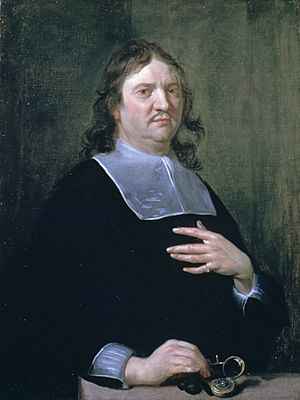Henry Oldenburg facts for kids
Henry Oldenburg (born around 1618 – died September 5, 1677) was a very important person in the world of science during the 1600s. He was from Germany and worked as a theologian (someone who studies religion) and a diplomat (someone who represents their country). He is best known for helping to create a key part of modern science: peer review. This is where experts check each other's work.
Oldenburg was also a master at connecting with people. He had a huge network of friends and colleagues across Europe. When the Royal Society was started in London, he became its first Secretary. His main job was to manage all the letters and messages with scientists in other countries.
Henry Oldenburg's Early Life
Henry Oldenburg was born in Bremen, Germany, around 1618. He studied theology and finished his degree in 1639. He was very good at languages, knowing German, Latin, and Greek from a young age.
During the 1640s, he lived in England and likely worked as a tutor. In 1648, he left England and spent time in the Dutch Republic. There, he learned to speak Dutch fluently.
In 1653, he returned to London as a diplomat. He represented the city of Bremen to Lord Protector Oliver Cromwell. This was during the First Anglo-Dutch War.
Oldenburg then settled in England. He became good friends with Robert Boyle, a famous scientist. He also knew John Milton, a well-known writer. Milton said Oldenburg spoke English better than any other foreigner he knew. Oldenburg later became a tutor for Boyle's nephew, Richard Jones. He traveled with Jones through France from 1657 to 1660. While there, Oldenburg learned French, becoming fluent in another European language.
In 1668, Oldenburg married Dora Katherina Dury in London. Through his connections, he met other important thinkers. These included Samuel Hartlib, who also had a large network of contacts. Oldenburg took over many of Hartlib's connections. He also met the philosopher Baruch Spinoza during a trip to the Netherlands.
Secretary of the Royal Society
After the Restoration of the monarchy in 1660, Henry Oldenburg became an early member of the Royal Society. This society was founded to promote science. He served as its first Secretary, along with John Wilkins. In this role, he kept in touch with many scientists across Europe.
Oldenburg also became the first editor of the Philosophical Transactions of the Royal Society. This was a very important scientific journal. He started the practice of sending submitted articles to other experts. These experts would check the quality of the work before it was published. This was the beginning of both the modern scientific journal and the idea of peer review. The Philosophical Transactions of the Royal Society is still published today. It is the longest-running scientific journal in the world.
In 1667, during the Second Anglo-Dutch War, Oldenburg was briefly put in prison. He was accused of being a spy. He was held in the Tower. Oldenburg also shared information with the politician Sir Joseph Williamson.
Henry Oldenburg was generally healthy throughout his life. However, he became very ill on September 3, 1677. He died two days later at his home in Pall Mall, London. He was buried on September 7. His wife died just ten days after him.
See also


